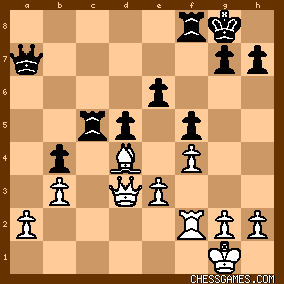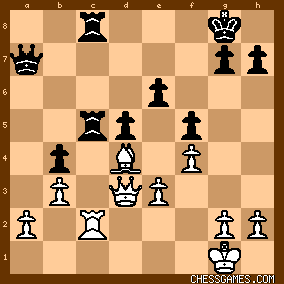|
< Earlier Kibitzing · PAGE 2 OF 3 ·
Later Kibitzing> |
| May-16-13 | | kevin86: Black could fight on,but his pieces are uncoorinated and the pawns are weak-so why bother? |
|
| May-16-13 | | Abdel Irada: <greystar69: <Marco65> Are you saying that you found this puzzle as easy as Pi(e)?> Yes, but only to the 14th decimal place.
The real test is not pi but /i/. Only those who can solve the puzzle in less than √-1 seconds are admitted to the innermost circle. (And if you can manage to solve it in both ∏ *and* √-1 seconds, you may fairly call yourself pi-/i/ed.) ∞ |
|
| May-16-13 | | howlwolf: I don't know about math humor. |
|
May-16-13
 | | Phony Benoni: Not many people understand math humor. That figures. |
|
| May-17-13 | | whiteshark: If you understand math humor you probably don't have friends. http://tetrahedral.blogspot.de/2012... ;) |
|
May-17-13
 | | HeMateMe: Q: What did the absolute value integer say to his detractors? A: I'm always positive! |
|
| May-17-13 | | Abdel Irada: <HeMateMe: Q: What did the absolute value integer say to his detractors? A: I'm always positive!>
This is true until the detractors become subtractors and reduce his value to zero. ∞ |
|
| May-17-13 | | diceman: <Phony Benoni: Not many people understand math humor.> Its easy as Pi. |
|
May-18-13
 | | HeMateMe: <Benoni> I liked your link to math/engineering jokes. Especially the "not my job" road striper photo. |
|
| May-18-13 | | Abdel Irada: I rather liked the cartoon depicting a discussion between /i/ and pi. </i/: "Be rational."
pi: "Get real.">
∞ |
|
Aug-04-16
 | | Phony Benoni: OK, we've got a bishop pinning a bishop here. That usually works out better if the bishop is pinning a rook, so look at 26.Rxc5 Rxc5 27.Rc2 Rfc8. Now we can only reinforce with the queen, and can only do that by the ridiculous 28.Qb5. Wait a second: that's a cross pin situation. So: <26.Rxc5 Rxc5 27.Rc2 Rfc8 28.Qb5 Rxc5 29.Rxc8+ Kf7 30.Bxa7>, and that looks like an extra piece. |
|
Aug-04-16
 | | Penguincw: < Phony Benoni: Not many people understand math humor. > Same goes for fractions; 3 out of 2 people don't understand them. ---
Entering this puzzle, I was 3/2 on the week and month. As a result, I spent some extra time trying to solve this puzzle. Normally, me trying to solve a mid or late week puzzle is like a circle: pointless. (damn, all these math puns, that ain't good: math puns are the first sine of madness) I did not get it though. I should've gotten it, as it looks pretty easy. I did come up with moves such as 26.Bxg7 and 26.Bxc5. 3/4 this week and month. |
|
| Aug-04-16 | | thegoodanarchist: There is only one math joke that is actually funny. If you want, I will tell it |
|
| Aug-04-16 | | nalinw: %^^&*&**(
I got up to the reload with Rc2 but just didn't see Qb5. Instead I was looking for ways to swing over to a king side attack. |
|
| Aug-04-16 | | YouRang: Meh - I missed it. Didn't see 28.Qb5! as the winning continuation, but indeed, whichever way it goes, white comes out a piece to the good. |
|
| Aug-04-16 | | knutinge: Ich finde fast immer die Lösung bei Schachproblemen, weil ich weiß, dass etwas geht!
In einer Turnierpartie hätte ich es NIE gefunden!
Warum bloß? |
|
| Aug-04-16 | | nasher: Ok <thegoodanarchist>, what is the joke ? |
|
| Aug-04-16 | | gofer: Looked at this one for a while. I realised eventually that move order is key because there is no point trying to exploit the pin until it exists, so moves like <26 a3> fail to <26 ... Bxd4>. So this means that it is necessary to play Rxc5 immediately to set up the pin first. After that we have to work if we can exploit the pin we have made, can we either bring more forces to attack the pinned piece or exploit the position of our opponents supporting pieces. This pin is the latter. Only Rf8 can come to support the pinned Rc5 and that is only from c8 where it can be taken without losing tempo due to the check. So we get the simple combination... <26 Rxc5 Rxc5>
<27 Rc2 Rc8>
Now we just need to exploit the pinned piece one more time and the pin will work... <28 Qb5! ...>
The rest is history, the best black can hope for is being in a Q+B v 2R end game, which is not going to be easy
to survive... |
|
| Aug-04-16 | | gofer: knutinge: <Pattern Recognition> Sie müssen diese einfachen Muster lernen können sie in Ihre Spiele zu nutzen... oder
Sie müssen lernen zu gehen, bevor Sie ausführen können lernen! |
|
| Aug-04-16 | | agb2002: The material is identical.
Black threatens Bxd4 and Rxa2.
White can exploit the position of the black queen with 26.Rxc5 Rxc5 27.Rc2 Rc8 28.Qb5: A) 28... Rxc2 29.Bxa7 Rxa2 30.Bc5 (due to 30... Rc8# and 30... Rxa7) A.1) 30... Rac2 31.Bd4 + - [Q+B vs 2R+P] (threatens Qd7 and Qxb4; 31... Raa2 32.Qe8#). A.2) 30... Ra1+ 31.Kf2 doesn't seem to change anything. B) 28... Rxb5 29.Rxc8+ Kf7 30.Bxa7 Ra5 31.Bc5 Rxa2 32.Bxb4 followed by Rc3 + - [B]. C) 28... R8c7 29.Qe8#.
D) 28... Kf7 29.Bxc5 Qc7 30.Qxb4 + - [B+P]. |
|
| Aug-04-16 | | morfishine: <26.Rxc5> |
|
| Aug-04-16 | | zb2cr: Found this one quickly. Takes real confidence to play this kind of combination. |
|
| Aug-04-16 | | LlanelliCC: Gofer. Exactly. You start early and learn thousands of patterns, like the one in today's puzzle, and then they become automatic when you play in a real game. |
|
| Aug-04-16 | | Once: This is one of those "I want to, I can't, I can" sort of puzzles. From the opening position, the move that we really want to play is 26. Rxc5. This would replace the black bishop on c5 (which can't be pinned diagonally) with a black rook (which can). So that leads us to 26. Rxc5 Rxc5: 
click for larger viewNow that the black Rc5 is pinned we follow the usual prescription of adding more pressure to the pin. That leads us to 27. Rc2 Rfc8 
click for larger viewWhite attacks c5 for a second time. Black defends it for a second time. Now white wants to be able to attack c5 for a third time. You see, there is a basic unfairness in chess. All other things being equal, the attacking side can sometimes attack a pinned piece with more pieces than can defend it. This is because the pinned piece can't defend itself. So if material is level, the attacker can find that he has an extra piece. This doesn't always work - opposite coloured bishops can mess it up - but it often applies. But white has a problem. He would like to add his queen into the attack, but there's no obvious way to do this. For example, he would like to warp his queen to d6 or capture on b4. Unfortunately these all take time to arrange - time that white doesn't have because black can easily unpin himself with a move like Qa5. That's when your eye falls on the move 28. Qb5.

click for larger viewIf it works it will add an extra attacker to the pinned Rc5. That's the "I want" part of the puzzle. I want to be able to play 28. Qb5. We might be tempted to reject 28. Qb5 out of hand because it puts two pieces en prise - the white queen and the white rook. That's the "I can't" phase. If we look a little deeper, we see that white wins material whichever way black captures. If 28...Rxc5 white doesn't play the disastrous 29. Bxa7 Rxc2. Instead he plays the zwischenzug 29. Rxc8+ Kf7 and only then 30. Bxa7 Or the game continuation when black finds himself with 2R vs Q+B, where the white queen and bishop pair will hoover up all the weak black pawns. So our Qb5 is an "I can" after all. |
|
| Aug-04-16 | | patzer2: Black's 25...Qa7? meets with disaster in the form of a pinning combination starting with 26. Rxc5!, which also solves today's Thursday puzzle. The follow-up move 28. Qb5! is available to put pressure on the pinned piece because of the in-between move (a.k.a. zwischenzug or intermezzo) threat 28...Rxb5 29. Rxc8+ Kf7 30. Bxa7  which leaves White a piece up (i.e. extra Bishop). which leaves White a piece up (i.e. extra Bishop). Instead of 25...Qa7?, allowing 26. Rxc5!  , Black should have played 25...Rfa8 = (0.17 @ 22 depth, Deep Fritz 15). , Black should have played 25...Rfa8 = (0.17 @ 22 depth, Deep Fritz 15). |
|
 |
 |
|
< Earlier Kibitzing · PAGE 2 OF 3 ·
Later Kibitzing> |





